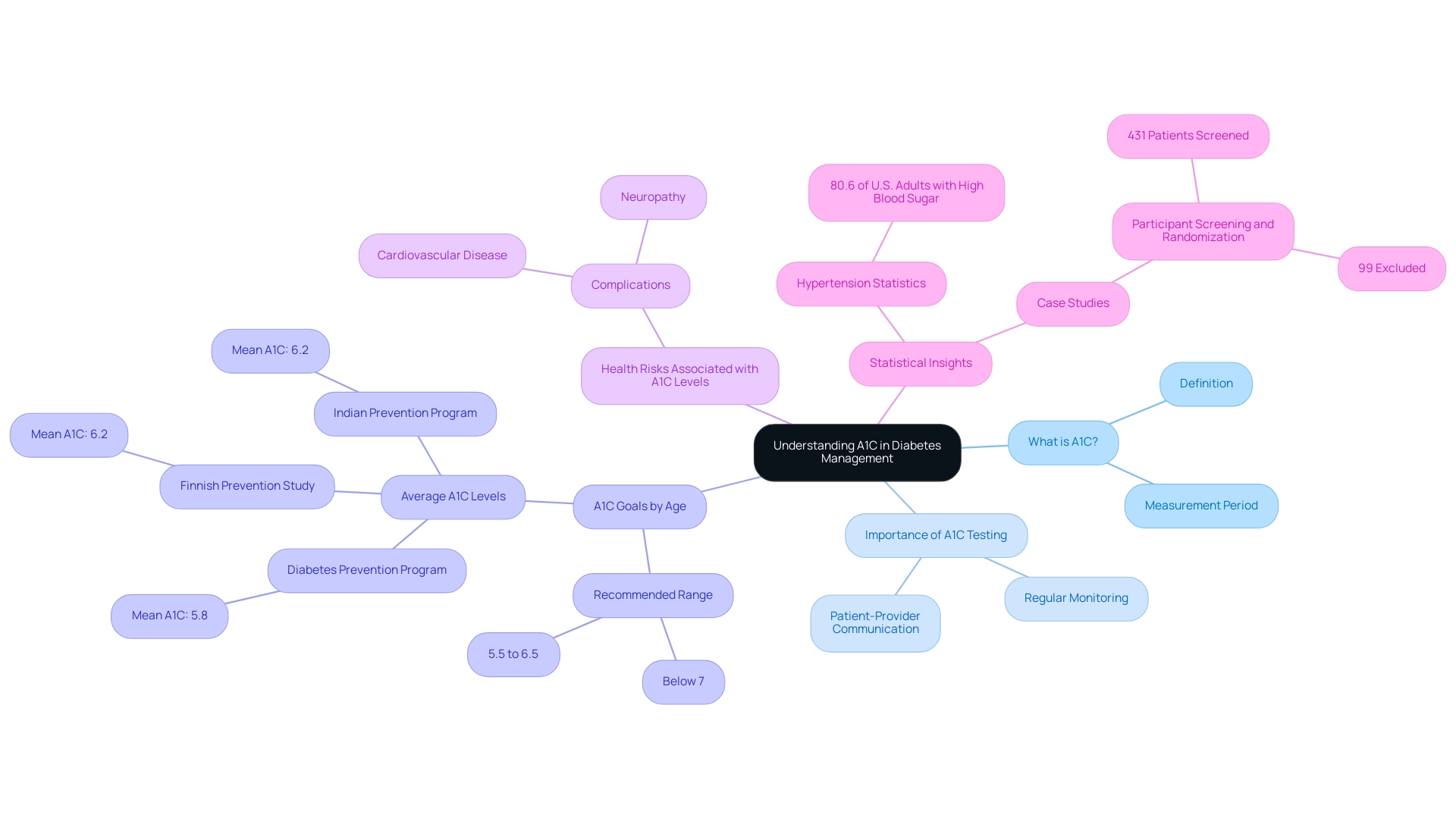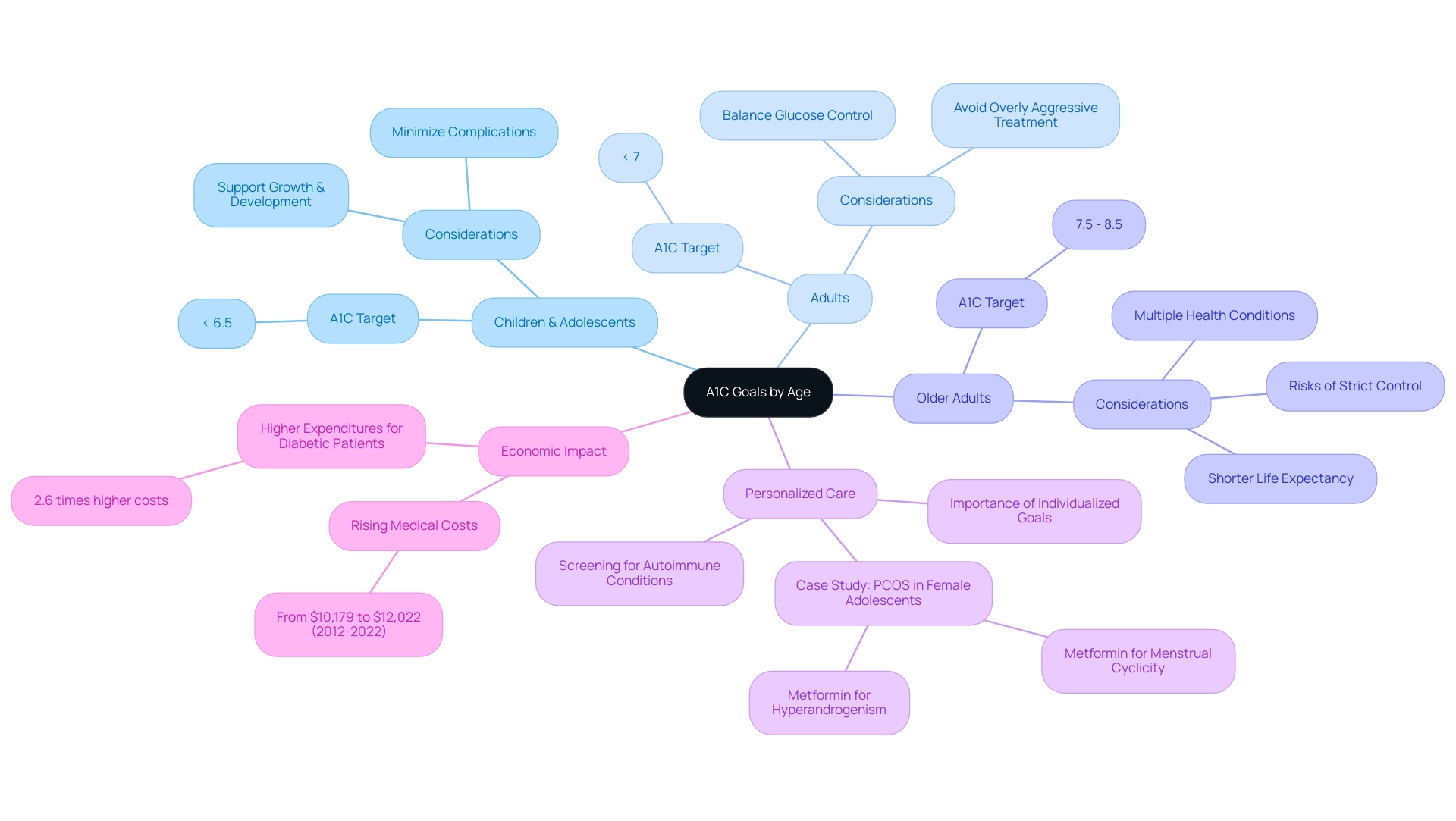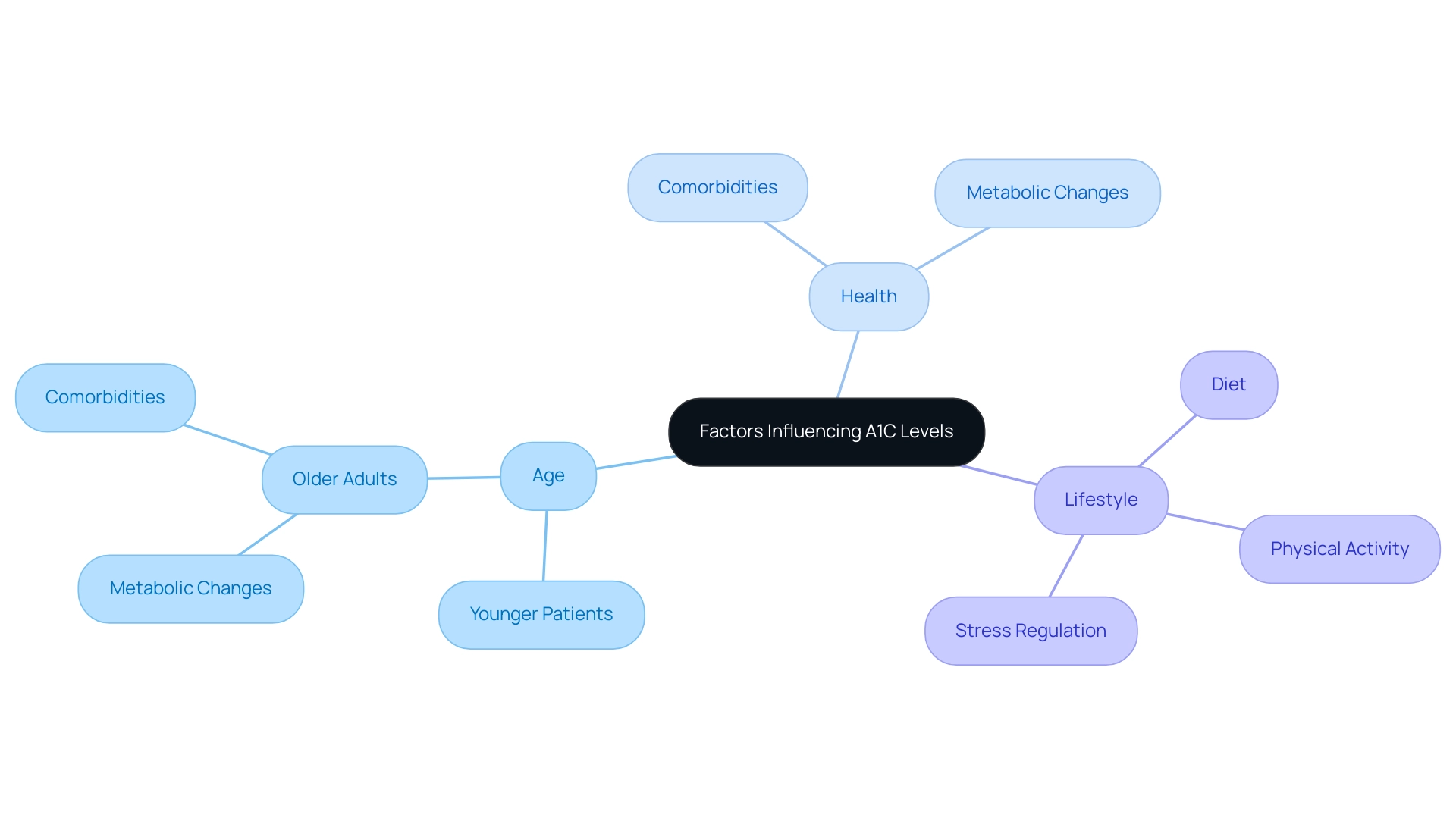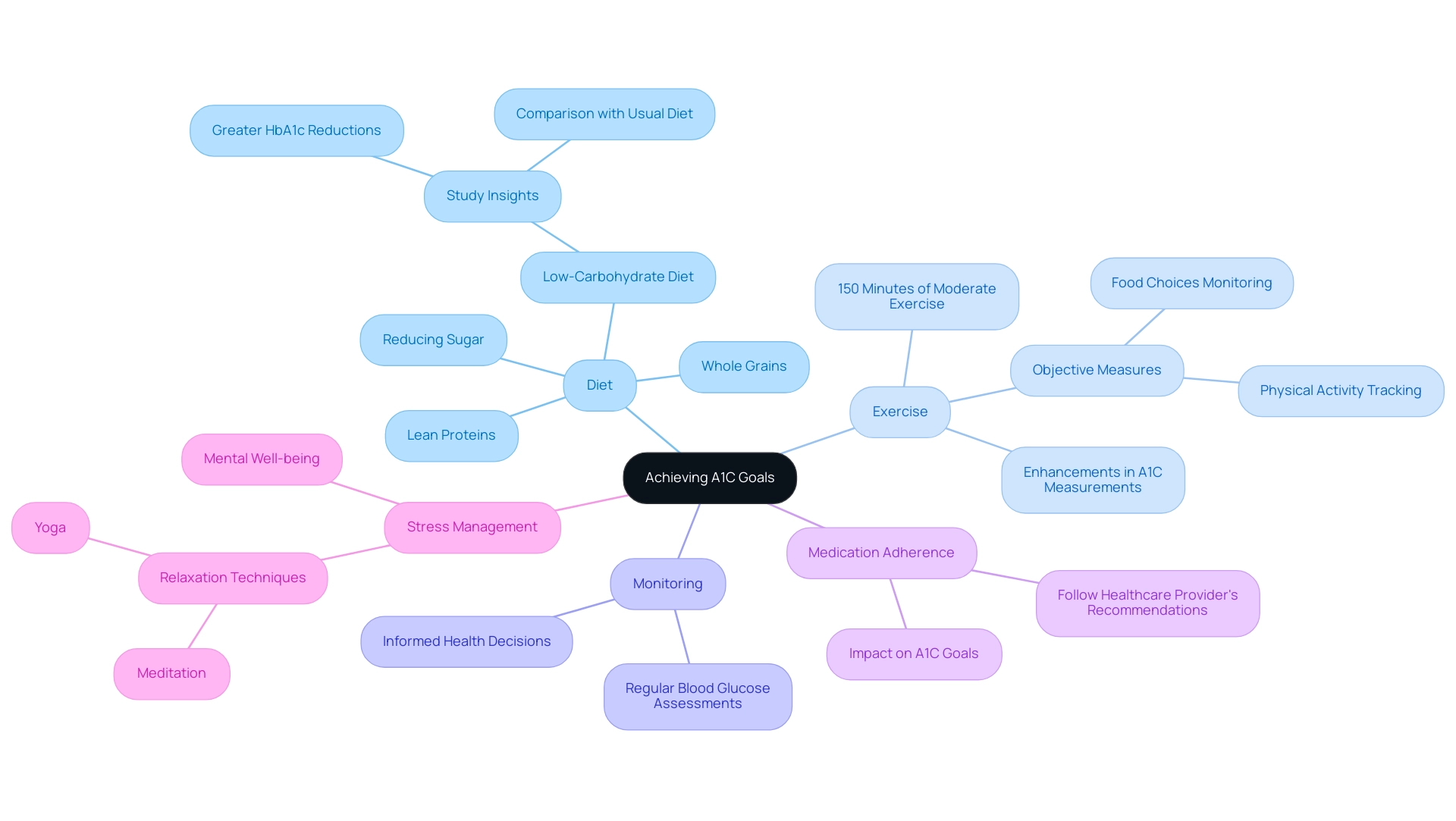Overview
This article highlights the recommended A1C goals tailored for various age groups, emphasizing the importance of personalized targets in managing diabetes. It's essential to understand that children and adolescents should aim for an A1C below 6.5%. For adults, the typical target is below 7%. Meanwhile, older adults may find it beneficial to have a more lenient range of 7.5% to 8.5%. This reflects the necessity for individualized approaches based on each person's unique health circumstances and risks.
You're not alone in this journey. As you navigate your health, remember that these targets are not just numbers; they are part of a broader strategy to help you live your best life. We encourage you to reach out for support and resources tailored to your needs. Together, we can work towards achieving these goals, ensuring that your diabetes management plan feels right for you.
Introduction
In the realm of diabetes management, understanding the A1C test is crucial for anyone striving to maintain optimal health. This vital assessment measures average blood glucose levels over the past months, offering essential insights into long-term glucose control. It's important to recognize that recommended A1C targets can vary based on age and health status, highlighting the need for personalized strategies.
As diabetes affects millions, it's understandable to feel overwhelmed by the factors that influence A1C levels—from lifestyle choices to adherence to medical advice. This article will explore the significance of A1C testing, outline recommended goals for different demographics, and present effective strategies for achieving those targets. Remember, you are not alone on this journey; we are here to support you every step of the way.
Understanding A1C: The Key to Diabetes Management
The A1C test, also known as hemoglobin A1C, is a vital tool for individuals managing high blood sugar. It measures the average blood glucose levels over the past two to three months, expressed as a percentage. Higher A1C values indicate poorer blood sugar control, and for those diagnosed with this condition, an A1C figure below 7% is generally recommended to help reduce the risk of complications, such as cardiovascular disease and neuropathy.
Understanding the A1C test is crucial for effective management of your condition. Referring to the A1C goals by age chart can provide valuable insights into long-term glucose regulation and guide your treatment choices. Recent statistics show that mean A1C values in various prevention programs, including the Diabetes Prevention Program, the Finnish Prevention Study, and the Indian Prevention Program, range from 5.8% to 6.2%. These figures emphasize the importance of maintaining A1C levels within a target range, as illustrated in the A1C goals by age chart, to lower the risk of developing diabetes-related complications. Regular A1C testing is essential, and experts stress its significance.
Ann L. Albright, PhD, RD, from the CDC, highlights that aiming for an A1C range of 5.5% to 6.5% can identify many individuals at high risk. Her findings suggest that timely interventions can lead to significant reductions in risk, underscoring the importance of A1C testing and the A1C goals by age chart in managing high blood sugar levels. Additionally, ensuring access to A1C testing and fostering open communication between patients and healthcare providers are crucial for effective care.
Recent findings reveal that 80.6% of U.S. adults diagnosed with high blood sugar have a systolic blood pressure of 130 mmHg or higher or are on medication for hypertension. This statistic highlights the interconnectedness of managing blood sugar levels and cardiovascular health, reinforcing the need for regular A1C monitoring as outlined in the A1C goals by age chart.
Moreover, case studies illustrate the effectiveness of A1C testing in managing blood sugar. In a randomized study, out of 431 patients screened, 99 were excluded for not meeting inclusion criteria, mainly due to A1C values, age, or chronic conditions. This thorough screening process ensures that only eligible individuals are included for accurate outcome assessments, further emphasizing the importance of A1C testing in managing the condition effectively.
In summary, the A1C test is more than just a number; it is a crucial indicator of overall health for individuals with this illness, which can be better understood through the A1C goals by age chart. By understanding and monitoring A1C levels, you can take proactive steps toward improved health outcomes and a better quality of life. Access to A1C testing and regular contact with your healthcare provider are essential for achieving these goals.
At At&T Solutions, we are committed to providing resources and support for individuals coping with diabetes, ensuring you have the tools necessary for effective health management. Remember, you're not alone in this journey; we are here to support you every step of the way.

A1C Goals by Age: What Are the Recommendations?
Understanding A1C goals by age is crucial in managing diabetes, and these targets can vary significantly across different age groups. The American Diabetes Association recommends that children and adolescents strive for an A1C target of less than 6.5%. This goal is set to support their growth and development while minimizing the risk of complications related to diabetes.
For adults, the typical A1C goal is below 7%, which aims to balance effective glucose control with the potential risks of overly aggressive treatment. It's important to recognize that what works for one person may not be suitable for another.
Older adults, especially those with shorter life expectancies or multiple health conditions, might find a more lenient target of 7.5% to 8.5% beneficial. This approach considers the complexities of managing diabetes in this age group, where the risks of strict control can sometimes outweigh the benefits. The American Diabetes Association emphasizes that these recommendations should be tailored to each individual's circumstances, ensuring that treatment plans are effective and considerate of the patient's overall health.
Katie Bowles notes that 'these results are not applicable to the whole US type 1 population,' highlighting the importance of personalized care approaches in managing diabetes. Real-life examples, such as a case study involving female adolescents with type 2 diabetes, illustrate the need for tailored A1C targets. In this instance, the evaluation of polycystic ovary syndrome (PCOS) showed that Metformin could improve menstrual cyclicity and hyperandrogenism.
These findings underscore the importance of personalized care that takes into account both blood sugar management and related health conditions.
As we look ahead to 2025, statistics reveal that excess medical costs per person related to diabetes have risen significantly, from $10,179 in 2012 to $12,022. Furthermore, average medical expenditures for individuals with diagnosed blood sugar-related health issues are 2.6 times higher than costs for those without the condition. This increase highlights the need for effective control strategies, including appropriate A1C targets, to help reduce long-term healthcare expenses.
The American Diabetes Association continues to advocate for personalized A1C goals, recognizing that effective diabetes management is not a one-size-fits-all solution. Additionally, testing for other autoimmune disorders is recommended shortly after a type 1 diagnosis, further emphasizing the need for customized treatment approaches.
At T2DSolutions, we are committed to providing newly diagnosed patients with the resources and support they need to understand their A1C goals and management strategies. Our platform serves as a comprehensive hub for blood sugar management education, helping patients navigate their journey with personalized care and information. You're not alone in this journey; we are here to support you every step of the way.

Factors Influencing A1C Levels: Age, Health, and Lifestyle
A range of factors, including age, general health, and lifestyle decisions, greatly affect A1C values in individuals with blood sugar issues. This can be understood better through the A1C goals by age chart. For younger patients, the chart often recommends more stringent A1C goals due to their longer life expectancy and lower risk of diabetes-related complications. In contrast, older adults may experience metabolic changes and comorbidities that necessitate higher A1C targets. This reflects a more nuanced approach to diabetes care, recognizing that each individual's journey is unique.
Lifestyle factors play a critical role in determining A1C values. Diet, physical activity, and stress regulation can profoundly impact blood sugar control. For instance, a balanced diet rich in whole foods and regular exercise can lead to substantial improvements in A1C readings. It's understandable to feel overwhelmed by these recommendations, but small, consistent changes can make a significant difference.
Real-world instances demonstrate this: individuals who embrace healthier eating habits and participate in regular physical activity frequently observe a reduction in their A1C measures. This reinforces the link between lifestyle choices and blood sugar control, showing that you’re not alone in this journey—many have found success through commitment and support.
Statistics indicate that by 2025, 8.0% of U.S. adults aged 18 years or older with diagnosed blood sugar issues will have a non-HDL level of 190 mg/dL or above. This highlights the significance of thorough health oversight strategies. Furthermore, the rising medical costs associated with diabetes—from $10,179 per person in 2012 to $12,022 in 2022—underscore the financial implications of inadequate A1C control and the necessity for effective lifestyle interventions.
Emerging methods for monitoring blood sugar, such as estimated average glucose and glucose time in range, are gaining traction within the medical community. These alternatives to traditional HbA1c testing provide a more comprehensive view of blood sugar control, although they are not yet widely available. Ongoing research and development in these fields are crucial for improving blood sugar regulation.
As R.A.P. noted, 'developed methods, collected data, contributed to the discussion, and reviewed/edited the manuscript,' emphasizing the importance of expert insights in understanding A1C levels and the oversight of health conditions. In addition, the focus on community and collaboration underscores that managing this condition is a collective journey, where shared knowledge and support can lead to improved health outcomes.
At T2DSolutions, we recognize the importance of understanding the interplay of age, health status, and lifestyle choices in setting realistic and achievable goals, as outlined in the A1C goals by age chart. Our platform aims to provide resources, educational materials, and community support to help individuals navigate their diabetes care journey effectively. By focusing on these factors, individuals can work towards improved health outcomes with the support of 2 Solutions.

Strategies for Achieving Your A1C Goals: Tips and Resources
Achieving your A1C goals by age chart requires a multifaceted approach that combines lifestyle changes with medical management. At T2DSolutions, we understand that this journey can feel overwhelming, and we are committed to providing resources and support for newly diagnosed patients like you. Here are some effective strategies to consider:
-
Diet: Emphasize a balanced diet that includes whole grains, lean proteins, and an abundance of fruits and vegetables. It's understandable to feel confused about what to eat. Research indicates that reducing sugar and refined carbohydrates can lead to significant improvements in blood sugar. For instance, a study titled 'Usual Diet Group Comparison' found that participants following a low-carbohydrate diet experienced greater reductions in HbA1c compared to those adhering to standard dietary advice. In the usual diet group, low-density lipoprotein rose by 2.9 mg/dL, highlighting how dietary choices impact metabolic health.
-
Exercise: Participating in regular physical activity is essential for improving insulin sensitivity and reducing blood sugar values. Aim for at least 150 minutes of moderate exercise each week. You might be surprised to learn that individuals who integrate regular exercise into their routines can see significant enhancements in their A1C measurements, aligning with the A1C goals by age chart. Future interventions should consider incorporating objective measures of physical activity and food choices to complement self-reported behaviors.
-
Monitoring: Regularly assessing your blood glucose readings is essential for understanding how your diet and activity influence your A1C. This self-monitoring can empower you to make informed decisions about your health. Remember, you're not alone in this; many people find this step crucial in their journey.
-
Medication Adherence: It is vital to follow your healthcare provider's recommendations regarding medications and insulin therapy. Consistent adherence to prescribed treatments can significantly influence your ability to achieve and sustain your A1C goals as outlined in the A1C goals by age chart. If you ever feel uncertain, don’t hesitate to reach out for support.
-
Stress Management: Implementing relaxation techniques such as yoga or meditation can assist in managing stress, which is recognized to affect blood sugar values. By prioritizing your mental well-being, you create a more conducive environment for effective management of blood sugar levels.
As Dr. Matthew J O’Brien notes, effective dietary strategies are crucial for lowering A1C levels. Utilizing resources such as diabetes education programs and support groups at T2 Solutions can provide additional guidance and encouragement. These platforms not only offer valuable information but also foster a sense of community, which can be instrumental in your journey toward better health. Remember, we are here to support you every step of the way.

Conclusion
Understanding and managing A1C levels is vital for anyone living with diabetes. The A1C test serves as a key indicator of long-term blood glucose control, guiding treatment decisions and helping to minimize the risk of complications. It's important to note that recommended A1C targets can vary by age and health status, making personalized strategies essential for effective management. For instance, younger individuals may aim for stricter goals, while older adults might benefit from more lenient targets, reflecting the need for tailored approaches.
Lifestyle factors play a significant role in influencing A1C levels. A balanced diet, regular physical activity, and effective stress management can lead to substantial improvements in blood sugar control. Moreover, adhering to medication and consistently monitoring blood glucose levels are crucial components of a successful diabetes management plan. By making informed lifestyle choices and utilizing available resources, you can work towards your A1C goals with confidence.
Ultimately, achieving optimal A1C levels is a collective journey that requires support, education, and commitment. With the right strategies and resources, you can take proactive steps towards better health outcomes and an improved quality of life. Remember, the emphasis on understanding and managing A1C levels not only benefits those with diabetes but also contributes to a broader awareness of the importance of holistic health management. You're not alone in this journey, and we are here to support you every step of the way.
Frequently Asked Questions
What is the A1C test and what does it measure?
The A1C test, also known as hemoglobin A1C, measures the average blood glucose levels over the past two to three months, expressed as a percentage.
What do higher A1C values indicate?
Higher A1C values indicate poorer blood sugar control.
What is the recommended A1C target for individuals diagnosed with high blood sugar?
An A1C figure below 7% is generally recommended to help reduce the risk of complications, such as cardiovascular disease and neuropathy.
Why is understanding the A1C test important?
Understanding the A1C test is crucial for the effective management of high blood sugar and can guide treatment choices.
What do the A1C goals by age chart provide?
The A1C goals by age chart provides valuable insights into long-term glucose regulation and helps in guiding treatment decisions.
What are some statistics regarding A1C values in prevention programs?
Mean A1C values in various prevention programs range from 5.8% to 6.2%, emphasizing the importance of maintaining A1C levels within a target range.
What A1C range does Dr. Ann L. Albright recommend for identifying individuals at high risk?
Dr. Ann L. Albright recommends aiming for an A1C range of 5.5% to 6.5% to identify individuals at high risk.
What is the significance of regular A1C testing?
Regular A1C testing is essential for managing high blood sugar levels and reducing the risk of diabetes-related complications.
What percentage of U.S. adults with high blood sugar have elevated systolic blood pressure?
80.6% of U.S. adults diagnosed with high blood sugar have a systolic blood pressure of 130 mmHg or higher or are on medication for hypertension.
How does A1C testing contribute to effective diabetes management?
A1C testing helps in accurately assessing blood sugar levels and determining eligibility for interventions, which is crucial for effective diabetes management.
What role does At&T Solutions play for individuals coping with diabetes?
At&T Solutions is committed to providing resources and support for individuals coping with diabetes, ensuring they have the tools necessary for effective health management.
